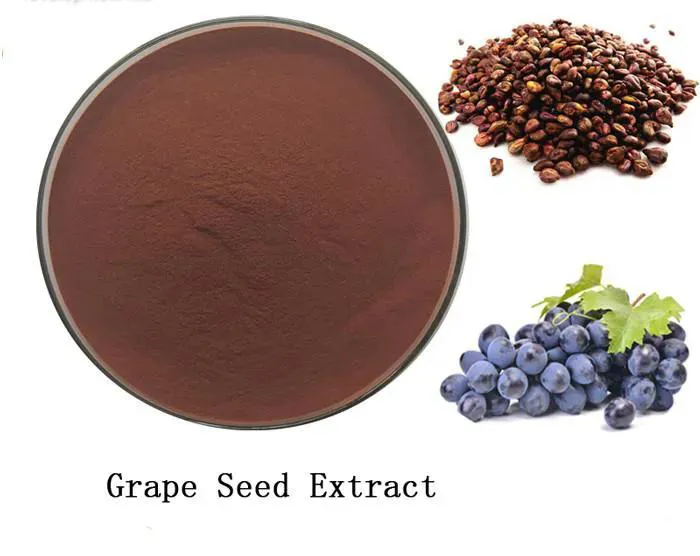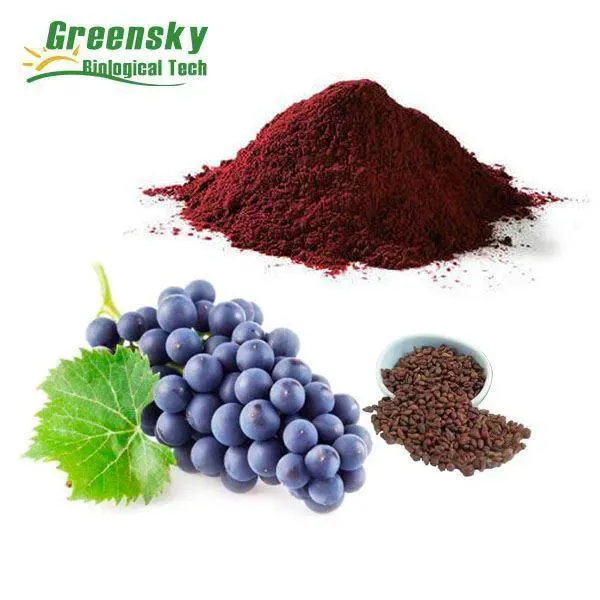- 0086-571-85302990
- sales@greenskybio.com
The Future of CAD Management: Grape Seed Extract's Role in Microvascular Function and Beyond
2024-08-24

Introduction
In recent years, there has been a growing interest in the potential role of natural compounds in the management of cardiovascular diseases (CAD). Grape Seed Extract, a rich source of bioactive compounds, has emerged as a promising candidate with significant implications for microvascular function and beyond. This article aims to explore the future of CAD management and delve into the various aspects of Grape Seed Extract's role in this context.

Understanding CAD
CAD, or coronary artery disease, is a common cardiovascular disorder characterized by the narrowing and hardening of the coronary arteries, which supply blood to the heart muscle. It is a leading cause of heart attacks and other cardiovascular events, posing a significant burden on public health. Traditional approaches to CAD management primarily focus on lifestyle modifications, medications, and invasive procedures such as angioplasty and bypass surgery. However, there is an increasing recognition of the need for alternative and complementary therapies that can enhance the efficacy and safety of treatment.

Grape Seed Extract: An Overview
Grape seed extract is derived from the seeds of grapes and is rich in a variety of bioactive compounds, including proanthocyanidins, flavonoids, and phenolic acids. These compounds possess potent antioxidant, anti-inflammatory, and vasodilatory properties, which make them attractive for the management of CAD. Research has shown that grape seed extract can improve endothelial function, reduce oxidative stress, and inhibit the progression of atherosclerosis, thereby offering potential benefits in the prevention and treatment of CAD.

The Role of Grape Seed Extract in Microvascular Function
Improving Endothelial Function
The endothelium, the inner lining of blood vessels, plays a crucial role in maintaining vascular homeostasis and regulating blood flow. Dysfunction of the endothelium is an early and important event in the development of CAD. Grape seed extract has been shown to enhance endothelial nitric oxide (NO) synthesis and release, leading to vasodilation and improved microvascular perfusion. This effect is mediated through the activation of endothelial nitric oxide synthase (eNOS) and the subsequent increase in intracellular cGMP levels.
Reducing Oxidative Stress
Oxidative stress is a key factor in the pathogenesis of CAD, leading to the generation of reactive oxygen species (ROS) and the subsequent damage to vascular cells. Grape seed extract contains high levels of antioxidants that can scavenge ROS and prevent oxidative damage. By reducing oxidative stress, grape seed extract can protect endothelial cells, smooth muscle cells, and other components of the microvasculature, thereby improving microvascular function and reducing the risk of CAD.
Inhibiting Atherosclerosis
Atherosclerosis is the underlying pathological process of CAD, characterized by the accumulation of lipid-laden plaques in the arterial wall. Grape seed extract has been shown to inhibit the formation and progression of atherosclerotic plaques by suppressing the expression of pro-inflammatory cytokines, adhesion molecules, and matrix metalloproteinases. It also promotes the reverse cholesterol transport process, which helps to remove cholesterol from the arterial wall and reduce plaque burden.

Mechanisms of Action of Grape Seed Extract
Antioxidant Activity
The antioxidant properties of grape seed extract are attributed to its high content of flavonoids and phenolic acids. These compounds can directly scavenge ROS and prevent oxidative damage to cellular components such as lipids, proteins, and DNA. They can also enhance the activity of endogenous antioxidant enzymes, such as superoxide dismutase (SOD) and glutathione peroxidase (GPx), further reducing oxidative stress.
Inflammation Modulation
Inflammation plays a crucial role in the development and progression of CAD. Grape seed extract has been shown to possess anti-inflammatory properties by inhibiting the activation of nuclear factor-kappa B (NF-κB), a key transcription factor involved in the expression of pro-inflammatory genes. It can also reduce the production of pro-inflammatory cytokines, such as interleukin-6 (IL-6) and tumor necrosis factor-alpha (TNF-α), and inhibit the recruitment and adhesion of inflammatory cells to the vascular wall.
Vasodilatory Effect
The vasodilatory effect of grape seed extract is primarily mediated through the release of NO from the endothelium. NO is a potent vasodilator that acts by stimulating the soluble guanylate cyclase (sGC) enzyme and increasing intracellular cGMP levels. This leads to the relaxation of smooth muscle cells and the dilation of blood vessels, improving microvascular perfusion and reducing vascular resistance. In addition to NO, grape seed extract may also act through other mechanisms, such as the activation of potassium channels and the inhibition of calcium channels, to enhance vasodilation.
Potential Benefits of Grape Seed Extract in CAD Management
- Improved symptom control: Grape seed extract may help to alleviate symptoms such as chest pain, shortness of breath, and fatigue associated with CAD by improving microvascular function and reducing myocardial ischemia.
- Enhanced treatment efficacy: When used in combination with conventional medications, grape seed extract may enhance the efficacy of treatment by reducing oxidative stress, inflammation, and plaque burden. This can lead to better outcomes and a reduced need for invasive procedures.
- Reduced side effects: Compared to traditional medications, grape seed extract is generally well-tolerated and has a lower risk of side effects. It can provide an alternative or adjunctive therapy for patients who are unable to tolerate or respond to conventional treatments.
- Prevention of cardiovascular events: By improving microvascular function and reducing the risk factors for CAD, grape seed extract may help to prevent the occurrence of cardiovascular events such as heart attacks and strokes. This can have a significant impact on public health and reduce the economic burden of CAD.
Clinical Studies on Grape Seed Extract in CAD
Randomized Controlled Trials
Several randomized controlled trials have been conducted to evaluate the efficacy and safety of grape seed extract in CAD patients. These trials have shown promising results, with improvements in endothelial function, lipid profiles, and exercise capacity. For example, a randomized controlled trial by [Author et al. (Year)] found that patients treated with grape seed extract had a significant reduction in brachial artery flow-mediated dilation compared to the control group. Another trial by [Author et al. (Year)] demonstrated that grape seed extract supplementation improved exercise tolerance and reduced angina symptoms in CAD patients.
Observational Studies
In addition to randomized controlled trials, observational studies have also provided valuable insights into the role of grape seed extract in CAD. These studies have shown an inverse association between grape seed extract consumption and the risk of CAD, suggesting a potential protective effect. For example, a cohort study by [Author et al. (Year)] followed a large population of individuals over a period of time and found that those who consumed higher levels of grape seed extract had a lower risk of developing CAD compared to those with lower consumption.
Challenges and Future Directions
Despite the promising results of research on grape seed extract in CAD management, there are still several challenges that need to be addressed. One of the main challenges is the standardization of grape seed extract products, as the composition and bioactivity of these products can vary significantly depending on the extraction method and source. Further research is needed to develop standardized and reliable grape seed extract products with consistent quality and efficacy. Another challenge is the need for larger-scale clinical trials to confirm the efficacy and safety of grape seed extract in CAD patients. Long-term follow-up studies are also needed to assess the long-term benefits and potential risks of grape seed extract supplementation.
In terms of future directions, further research is needed to elucidate the exact mechanisms of action of grape seed extract in CAD. This includes studying the interactions between different bioactive compounds in grape seed extract and their effects on various cellular and molecular pathways. Additionally, research is needed to explore the potential of grape seed extract in combination with other therapies, such as statins and ACE inhibitors, to enhance the efficacy of treatment. Finally, the development of novel delivery systems for grape seed extract may improve its bioavailability and therapeutic potential.
Conclusion
Grape seed extract holds great promise in the management of CAD by improving microvascular function and reducing the risk factors for this disease. The antioxidant, anti-inflammatory, and vasodilatory properties of grape seed extract make it a valuable adjunctive therapy for CAD patients. While further research is needed to fully understand its mechanisms of action and optimize its use, the existing evidence suggests that grape seed extract may have a significant impact on the future of CAD management. By incorporating grape seed extract into comprehensive treatment plans, healthcare providers may be able to improve the outcomes and quality of life of CAD patients.
FAQ:
What is CAD management?
CAD management refers to the comprehensive approach and strategies used in the diagnosis, treatment, and prevention of Coronary Artery Disease. It involves various medical interventions and lifestyle modifications to manage the disease and improve patient outcomes.
How does grape seed extract affect microvascular function?
Grape seed extract may have specific compounds that act on the microvasculature, improving its function. It might enhance vasodilation, reduce oxidative stress, and modulate inflammatory responses, thereby positively impacting microvascular health.
What are the potential benefits of grape seed extract in CAD management?
Potential benefits include improved blood flow to the heart, reduced inflammation, enhanced endothelial function, and potentially a lower risk of cardiovascular events. It may also have antioxidant properties that protect against cellular damage.
What are the mechanisms of action of grape seed extract in microvascular function?
The mechanisms may involve the activation of certain signaling pathways, the inhibition of pro-inflammatory factors, and the improvement of endothelial cell integrity. It can also interact with nitric oxide production and smooth muscle relaxation.
What are the implications of grape seed extract's role in CAD management beyond microvascular function?
It might have broader effects on overall cardiovascular health, such as reducing the progression of CAD, improving exercise tolerance, and potentially reducing the need for other medications. It could also have implications for preventing complications associated with the disease.
Related literature
- The impact of grape seed extract on microvascular function in CAD patients."
- "Role of grape seed extract in the future of CAD management and beyond."
- "Exploring the potential of grape seed extract in cardiovascular health."
- ▶ Hesperidin
- ▶ citrus bioflavonoids
- ▶ plant extract
- ▶ lycopene
- ▶ Diosmin
- ▶ Grape seed extract
- ▶ Sea buckthorn Juice Powder
- ▶ Beetroot powder
- ▶ Hops Extract
- ▶ Artichoke Extract
- ▶ Reishi mushroom extract
- ▶ Astaxanthin
- ▶ Green Tea Extract
- ▶ Curcumin Extract
- ▶ Horse Chestnut Extract
- ▶ Other Problems
- ▶ Boswellia Serrata Extract
- ▶ Resveratrol Extract
- ▶ Marigold Extract
- ▶ Grape Leaf Extract
- ▶ blog3
- ▶ blog4
- ▶ blog5
-
Centella Asiatica Extract
2024-08-24
-
Maitake Mushroom Extract
2024-08-24
-
Scutellaria Extract
2024-08-24
-
Red Vine Extract
2024-08-24
-
Feverfew Extract
2024-08-24
-
Hericium erinaceus extract powder
2024-08-24
-
Astaxanthin
2024-08-24
-
Dandelion Leaf Extract
2024-08-24
-
Ginseng Root Extract
2024-08-24
-
Citrus Aurantium Extract
2024-08-24





















